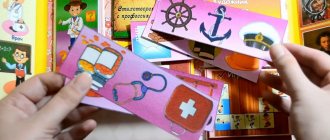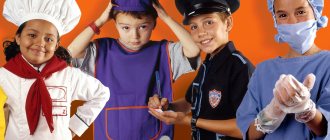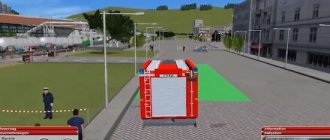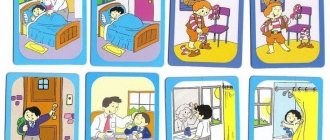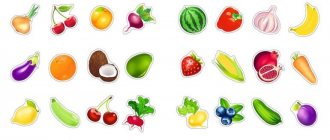Childhood
Didactic games to familiarize yourself with the outside world on the topic “Professions of People.”
The purpose of studying the topic: to continue to expand children’s understanding of various professions, their names and types of activities.
To cultivate respect for the work of adults, the desire to choose a profession and the need to work. “Who does what?”
Target.
Fix the names of actions performed by people of different professions. Progress of the game. Children take a picture of a person in a certain profession and say what he does. Cook... (cooks food), doctor... (heals people), teacher... (teaches children), builder... (builds houses), artist... (paints pictures), pianist... (plays the piano), writer... (writes books), dressmaker...(sews clothes), laundress...(washes clothes), cleaner...(mops floors), salesman...(sells goods), photographer...(takes photographs of people), teacher...(raises children), weaver...(weaves fabrics), machinist …(drives the train), controller…(checks tickets), typist…(types), etc. “Who knows more professions”
Purpose.
Teach children to correlate the actions of people with their profession, to form corresponding verbs from nouns (builder - builds, teacher - teaches, etc.). Progress of the game. Educator. I work in a kindergarten as a teacher. This is my profession. I teach you how to behave, play with you, draw, read you poems, stories, walk with you, put you to bed... This is my profession - to educate you. What is Irina Vladimirovna’s profession? She is preparing lunch for us. That's right, cook. What other professions do you know? (Answers.) Every adult necessarily learns some profession. Having mastered it, he goes to work and performs certain actions. What does a cook do? (Children: The cook cooks, bakes, fries, peels vegetables.) What does the doctor do? (Examines patients, listens, treats, gives medicine, gives injections, operations.) What does a tailor do? (Cuts, bastes, flogs, irons, tries on, sews.) The teacher names other professions - builder, teacher, shepherd, shoemaker, and the children name actions. “ Pronounce it correctly.”
Target.
Forming the correct pronunciation of sounds, consolidating the names of professions. Progress of the game. Learn pure tongue twisters or tongue twisters, jokes, so that when repeated, whistling and hissing sounds are clearly pronounced; — The watchmaker, squinting his eye, is fixing the watch for us. — The water carrier was carrying water from the water supply system. — The old watchman Tom is guarding the house. — The weaver is weaving fabric for Tanya’s dress. - The baker baked a bagel, a bagel, a loaf and a loaf of dough early in the morning - The roofer Kirill roofed the roof crookedly. Grisha was invited to re-roof. - Porridge, porridge, yogurt, our cook Masha, instead of porridge, she prepared an omelette for lunch. “Professions”
Purpose.
Fix the names of professions and actions that are performed by them. Progress of the game. You ask your child the question: “What does…..?” and name a representative of any profession, and the child answers. At first, it is better to take professions from which the answer follows - a teacher educates, a baker bakes, a janitor cleans. Alternate well-known professions with unfamiliar ones, and at the same time tell about professions unknown to the child. It turns out interesting if you ask in a row “What does a doctor do?”, “What does a veterinarian do?” (make out the difference), and then also “teacher” and “scientist”. Sometimes you hear interesting versions from children. “Give me a word.”
(“Add-ons”). Target. Develop logical thinking, attention, memory; learn to select words to rhyme. Progress of the game. Children suggest words and finish the poem. In the carpenter's bag you will find a hammer and a sharp... (knife). Any tool is available - a plane, and... (a chisel). Popov S.A. We must fight fire. We are brave workers. We are partners with water. People really need us. So who are we? - ... (firemen). I would definitely want to become a pilot, I would then take a plane to Moscow... (Fly). The pilot lifts Deleanu Liviu into the blue sky... (plane). Stepanov V. Kicked the goats out onto a cheerful hillock... (shepherd boy). Demchenko G. But our painter does not come into the house with a brush and a bucket: Instead of a brush, he brought a mechanical... (pump). Baruzdin S. So that people do not get wet in the rain The roofer covers with iron... (house). Baruzdin S. White sawdust is flying, flying from under the saw: This is a carpenter making frames and... (floors). Baruzdin S. Every day he brings a newspaper to our house... (postman). The roof is being painted in front of the children... (painters). I fly dolls in the morning. Today I... (nurse). Shigaev Yu. It's time to paint the rooms. They invited... (painter). Baruzdin S. The circus performer knows how to prance, animals and birds... (train). The future cabin boy brought us some southern fish... (sailor).
“Collection of didactic games for diagnosing labor skills for the senior group”
“I start the sentence, and you finish it”
Purpose:
to consolidate children’s ideas about the meaning and results of the work of people of different professions. If there were no teachers, then... If there were no doctors, then... If there were no janitors, then... If there were no drivers, then... etc.
Game "Guess what I'm doing?"
Goal:
Expand children's understanding of labor activities.
Develop attention. Progress of the game:
The teacher and children join hands and stand in a circle.
A child comes out into the center of the circle. Everyone goes in a circle and says: We don’t know what you’re doing, Let’s take a look and guess. The child imitates labor actions not only with movements, but also (if possible) with sounds. For example, he cleans the floor with a vacuum cleaner, hammers a nail, saws, drives a car, washes, chops wood, grates, etc. Children guess the actions. Game “What first, what then?” Purpose:
To clarify children’s knowledge about the rules for replanting indoor plants.
Progress of the game:
The teacher shows the children pictures depicting the stages of replanting indoor plants and asks them to arrange them in the order in which the actions are performed. 1) Overturn the pot and remove the plant from it. 2) Washing the pot. 3) Laying pebbles at the bottom of the pot. 4) Pour sand into the pot (height 1 cm). 5) Pour some soil into the pot on top of the sand. 6) Shaking off old soil from plant roots with a stick. 7) Cutting off rotten roots. Plant the plant in a pot so that the transition point between the stem and the root is on the surface, and cover it with soil. 9) Compaction of the earth. 10) Installing a pot with a plant on a pallet. 11) Water the plant at the root.
1) Overturn the pot and remove the plant from it. 2) Washing the pot. 3) Laying pebbles at the bottom of the pot. 4) Pour sand into the pot (height 1 cm). 5) Pour some soil into the pot on top of the sand. 6) Shaking off old soil from plant roots with a stick. 7) Cutting off rotten roots. Plant the plant in a pot so that the transition point between the stem and the root is on the surface, and cover it with soil. 9) Compaction of the earth. 10) Installing a pot with a plant on a pallet. 11) Water the plant at the root.
“Who works where?”
Goal:
to clarify children’s ideas about where people of different professions work and what their workplace is called.
Kindergartener; school teacher; doctor - in a hospital, clinic, kindergarten, school; cook - in the kitchen, dining room, restaurant, cafe... etc. “Who knows and can do this?” Goal:
to expand children’s ideas about what knowledge and skills people of different professions should have.
Knows children's poems, tells fairy tales, plays and walks with children... a teacher. Plays the piano, knows children's songs, teaches singing, dancing, plays musical games with children... music director. Knows the human body, can provide first aid, knows how to recognize and treat diseases... a doctor, etc. “Who does this?” Goal:
to train children in the ability to determine the name of a profession by the names of actions.
Cuts, styles, washes, combs, dries... hairdresser. Soaks, soaps, washes, shakes, dries, irons... the laundress. Packs, weighs, cuts, wraps, counts... the seller. Cleans, washes, fries, cooks, cooks, salts, tastes, feeds... cook, etc. "Who's doing what?" Goal:
to expand and clarify children’s ideas about the work (labor operations) of people of different professions.
The janitor sweeps, cleans, waters, rakes... The music director sings, plays, dances, teaches... The junior teacher (nanny) washes, cleans, wipes, covers, dresses, reads... etc. “Correct the mistake” Goal:
to teach children to find and correct mistakes in the actions of people of various professions.
The cook treats, and the doctor cooks. The janitor sells, and the seller sweeps. The teacher cuts the hair and the hairdresser checks the notebooks. The musical director does the laundry, and the laundress sings songs with the children... etc. “For a person in what profession is this necessary?” Goal:
to expand children’s understanding of the items necessary for a person in a certain profession.
Scales, counter, goods, cash register... - to the seller. Broom, shovel, hose, sand, crowbar, snow blower... - to the janitor. Washing machine, bath, soap, iron... - to the laundress. Comb, scissors, hair dryer, shampoo, hairspray, hair clipper... - to the hairdresser, etc. “Who needs what for work?” Goal:
to expand and clarify children’s ideas about the objects of the surrounding world (materials, tools, equipment, etc.) necessary for work by people of different professions.
For the teacher - a pointer, textbook, chalk, blackboard... For the cook - a pot, frying pan, knife, vegetable cutter, electric oven... For the driver - a car, spare tire, gasoline, tools... For the art teacher - brushes, easel, clay, paints... etc. “Clap your hands if it is necessary for ... (name of profession)” Purpose:
to exercise the ability to correlate words and phrases with a specific person’s profession.
Children are invited to clap their hands when they hear a word or phrase that is suitable for a profession, for example, a doctor: haircut, cold, scales, ambulance, sewing machine, seeing patients, fashionable hairstyle, washing powder, white coat, snowblower, etc. . “Who can name more actions?” (with a ball) Purpose:
to teach children to correlate the actions of people of different professions.
The teacher names a profession and, in turn, throws the ball to the children, who name what a person in this profession does. “Continue the sentence” Purpose:
to exercise the ability to complete sentences using words and phrases related to a person’s specific profession.
The cook cleans... (fish, vegetables, dishes...), The laundress washes... (towels, bed linen, bathrobes...). A teacher in the morning with children...(does exercises, has breakfast, conducts classes...) A janitor in the yard in winter...(shovels snow, clears areas, sprinkles sand on paths...), etc. "Who is on the photo?"; “Find and tell” (based on photographs) Purpose:
to consolidate children’s ideas about the work of kindergarten staff.
Children are asked to name a kindergarten employee (from a photograph) or select the desired photograph and tell about this person: what is their name, what room does they work in, what is they like, what does they do? “Let’s draw a portrait” (speech) Purpose:
to teach children to draw speech portraits of kindergarten employees.
Children are asked to compose a descriptive story (Who is this? What does he look like? What does he do? Etc.) about a kindergarten employee according to a model, plan, algorithm, using photographs, mnemonic tables. Game “Let's set the table for dolls” Purpose:
To teach children to set the table, to name the items necessary for serving.
Introduce the rules of etiquette (meeting guests, accepting gifts, inviting people to the table, behavior at the table). To foster humane feelings and friendly relationships. Progress of the game:
The teacher enters the group with an elegant doll. Children examine it and name items of clothing. The teacher says that today is the doll’s birthday, and guests will come to her - her friends. You need to help the doll set the festive table (doll furniture and dishes are used). The teacher plays out the stages of the activity with the children (wash hands, lay out a tablecloth, place a vase of flowers, a napkin, a bread box in the center of the table, prepare cups and saucers for tea or plates, and lay out cutlery nearby - spoons, forks, knives). Then the episode of meeting the guests is played out, the dolls are seated. In order to consolidate duty skills, children of older preschool age can be shown object pictures depicting the items listed above and asked to arrange them in order, determining the sequence of table setting.
Progress of the game:
There is a stove in front of the children. On it is a pot, a frying pan (toys, quite large, or real dishes)
; next to it is a set of vegetables (natural, a bowl of water, a knife, a spoon.
Educator: - I will teach you how to cook delicious soup from vegetables! Standing on the stove (show)
. ?
- Large saucepan.
— There is water in this pan. Look (scoops up water with a spoon and pours it back)
.
The water will boil soon, so it's time to peel the potatoes .
The teacher asks one of the children to find and give him potatoes , washes them in a bowl, and peels them. Children name the actions and repeat the names.
The teacher asks what the potatoes .
-It is white, clean without skin (skin)
.
- Throw it into the pan whole or. ?
- We need to cut it.
The teacher puts the onions in the pan. Then the children bring cabbage and carrots and watch as the teacher washes and chops the vegetables. Separately, he fries the onion in a frying pan (the children name the vegetable and the action with it)
.
Educator: “Listen,” says the teacher, “how the oil sizzles in a hot frying pan: sh-sh-sh. How does it sizzle?
The teacher puts the onions in the pan and stirs the soup.
He says: “It’s a pity that it doesn’t burn.”
our stove. But now we’ll cook vegetables, vegetable soup, on a real stove.”
When the cook arrives, the teacher hands him the pan. He is interested in what is in it, listens to the children , approves and clarifies their answers. He promises to cook soup.
Note. It is advisable that vegetable soup be prepared for lunch on this day. This will bring joy to the children.
№ 13. "Who's doing what?"
.
Goal: to develop the ability to correlate a person’s actions with his professional activities ; cultivate respect for working people.
The teacher hands out cards depicting representatives of various professions . Then he shows object pictures depicting the object of their activity, while asking questions: “Who builds houses?”
;
“Who sews dresses?”
,
“Who sells milk?”
etc. Examples of
children's : “A builder builds houses
,
“A tailor sews dresses
,
“A salesman sells milk
.
№ 14. “Who needs what?”
.
Goal: to systematize knowledge about the professions of a cook and a doctor ; about the objects of their labor.
The teacher calls two children . One wears a chef's cap, the other wears a doctor's cap (with a red cross)
.
He seats them at the table facing the rest of the class participants. Invites a third child to the table. He invites him to take the thing out of the box and, naming it, hand it over to its destination: either the cook or the doctor. The one who received the thing must name it and tell what it is used for, for example: “This is a meat grinder, you can grind meat, bread, onions and make cutlets
.
During the game, the composition of its participants changes once or, if time permits, 2 times.
№ 15. "Parsley goes to work"
.
Objectives: To teach how to classify objects according to their functional purpose (satisfying labor needs)
; cultivate a desire to help adults.
Equipment: Pictures depicting items necessary for play and work in the garden, in the kitchen, in the apartment; three layouts (garden, kitchen, room)
Progress of the game: A letter arrives from Petrushka, in which he says that he is visiting his grandmother. He plays, draws, walks, and also helps his grandmother. Today she gave him three tasks: plant carrots in the garden and water the flowers; cook soup; clean up the room (put away toys, wipe off dust, vacuum)
. However, Petrushka got confused in the tools and asks the guys to help.
The teacher offers the children models of the garden, kitchen and room and explains that they need to take one picture , look carefully, name the item, tell how to use it and what kind of work it is needed for, then put the picture on the corresponding model. For example, a vacuum cleaner is needed to clean a rug, it needs to be turned on and vacuumed, so a picture with a picture of a vacuum cleaner needs to be placed on the room layout. The teacher draws the children's attention to the fact that among the pictures with tools there are pictures with toys . They need to be selected and put in a box. The task is considered completed if all the pictures are arranged correctly .
At the end of the game, the teacher invites the children to tell Petrushka in a letter what items he needs to complete his grandmother’s tasks.
№ 16. «Professions»
.
Goal: to develop an understanding of professions , enrichment and replenishment of the vocabulary of words; development of imagination, thinking, word formation skills.
Inventory: Not required.
Content: The presenter begins the sentence, the children must complete it by inserting the missing words. Or he asks a question, and the children answer. There are many options for such games; below are a few examples.
Homework for children with special needs on the topic “Professions”
Topic: “Professions. Labor actions. Tools"
1. Remember and name the job of a person who: sews clothes - ..... (seamstress), paints walls - ......, does hair - ....., teaches children - ....., treats people - ......, regulates traffic - ………. In one word, what have you just listed? (professions). Tell us who your mom and dad are by profession.
2. Form new words by answering the question: What does it do?: • Sewed - what does it do? – sews • Put it down – what does it do? —……. (puts) • Built – what does it do? - …………. • Repaired – what does it do? - ……….
3. Name what instruments you know. (5 – 6 instruments). Tell us what someone needs: A saucepan is needed – ………., a saw – ……, flour – …….., brushes – ……., scissors – …….., a hammer – ….., a trowel – ……… , comb - ......., pointer - ......., syringe - .
4. From what - which one? From cast iron - cast iron, from metal - ....., from paper - ....., from steel - ...., from rubber - , from stone, from silver, from plastic, from gold, from oak, from wool, from cotton, from silk, their fur.
5. What they do: with an axe, hammer, shovel, scissors, needle, brush, saw.
6. Repeat the sentence, clearly all the words: HAIR IS CUT IN A HAIRDRESSER. A PLUMBER IS FIXING THE WATER PIPES. A POLICEMAN REGULATES TRAFFIC.
7. Write a story about any profession.
8. What do we do with tools?
With a shovel – we dig with scissors – …… With a saw – ………… with a needle – …………. With an ax – ……… hammer – …….. With a knife – ……….. with a rake – ………
9. Change words according to the example:
He digs - and you dig. Plants - and you plant. Loosens - ...... (looses) chops - ....... (chop) Saws – …….. (sawed) cuts – …….. (cut) Cuts out – …… (cut) sews – ……… (neck) Hammers – …….. (hammer) helps – …… ( help)
Topic: “Construction. Tools. Labor actions"
1. Tell us who works at the construction site. Name 4 – 5 professions of people taking part in construction. (Architect, builder, mason, welder, roofer, painter, carpenter, plasterer, plumber, etc.) Divide the words into syllables: CARPENTER, PAINTER, PLASTERER, ARCHITECT.
2. What is the name of a person who: • Lays walls of stone - mason • Lays a roof - ………… (roofer) • Plasters walls - ……… (plasterer) • Paints walls - ………….. (painter) • Makes frames, doors – ………(carpenter) • Welds metal structures – … (welder)
3. Say according to the example: • Painter – painters • Plasterer – • Architect – • Plumber – • Builder –
4. Count to 5 the instruments, matching the words correctly: Tell what they do with these instruments.
SHOVEL, HAMMER, SAW, AX (They dig the ground with a shovel, cut down trees with an ax, etc.)
Topic: “Transport. Professions in transport"
1. Remember and name what transport you know. (At least 4 titles). • What is the name of a vehicle that carries passengers? • What is the name of the transport that transports goods? • Name transport (2 EXAMPLES): GROUND – …, WATER – …, AIR –
2. Tell us who drives the transport: • The driver controls the car. • By train - ………… (Driver) • By plane - ……… (Pilot, pilot) • By ship - ………… (Captain)
3. Answer the questions using prepositions: • The car drives into the garage, and from the garage...... (LEAVES) • The car drives away from the house, and towards the house....... (DRIVES UP) • Drives along the road, and across the bridge…….. (DRIVES)
4. Answer according to the example: • Car – cars – many cars • Airplane – ……….. – many………. • Bus - …………………………. • Trolleybus – ……………………… • Truck – …………………………
5. Write a story about any transport according to the diagram. Write it down on a piece of album paper, draw it or stick a picture.
Topic: “Mail. Profession postman"
1. Tell me, who carries the mail home? (The postman carries mail from house to house.) What kind of mail does the postman deliver? (The postman delivers newspapers, magazines, letters, telegrams). What should you write before sending a letter, parcel or telegram? (You need to write your address). What do they indicate in the address? (In the address indicate your city, street, house number and apartment number). Why do you need to know it? Give your address.
2. Say with the word “POSTAL”: (pigeon, carriage, plane, stamp, train, box, bag) – EXAMPLE: POSTAL PIGEON, POSTAGE STAMP, etc.
3. Name the postal items (newspaper, magazine, letter, postcard) based on the following example:
• One newspaper – two newspapers – five newspapers
4. Determine the number of syllables in the words: NEWSPAPER, ENVELOPE, LETTER, PACKAGE.
5. Say according to the example: • Postman – postmen – many postmen • Letter – letters – many ………………….. • Magazine – ……………………………………………………… • Newspaper – … …………………………………….. • Package - ……………………………………..
Topic: “PROFESSIONS. Repetition"
1. Remember and name any 5 professions. Determine the number of syllables in the words: DRIVER, DOCTOR, SELLER, TEACHER. Tell us what people in these professions do. (For example: The driver drives the bus)
2. “One - many” • Driver – drivers – many drivers • Doctor – doctors – many ………………….. • Seller – ……………………………………. • Artist – ……………………………… • Firefighter – ………………………………. • Painter – ……………………………………..
3. Count to 5, correctly coordinating the words: DOCTOR, BUILDER, TEACHER.
4. Correct the mistakes: • The cook treats the children.
(No, the cook cooks, and the doctor treats the children) • The painter is building a house. (No. The builder builds the house, and the painter ………………….) • The hairdresser does the hair. (Yes, the hairdresser does the hair) • The photographer sews the clothes. • The seller teaches children. • A photographer paints pictures. Author of the material: Kravchuk Irina Anatolyevna


